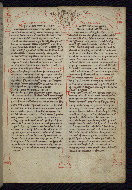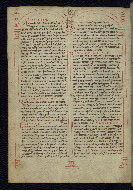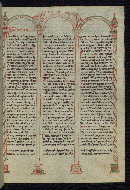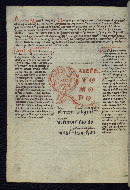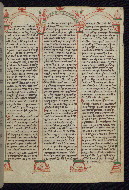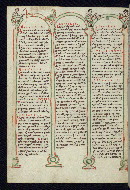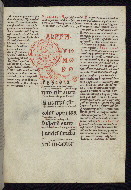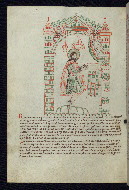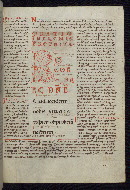Home > Digitized Walters Manuscripts
This document is a tranformation of a TEI P5 XML manuscript description incorporating images. If you have trouble reading special or non-Latin characters on this page, please make sure you have appropriate Unicode fonts installed and an up-to-date web browser.
Walters Ms. W.30, Gloss on The lamentations of Jeremiah
Browse images (Browse images in a new window) | TEI in XML format
W.30
Gloss on The lamentations of Jeremiah
Authority name: Gilbert, the Universal, d. 1134
As-written name: Giselbertus Autisiodorensis
Supplied name: Gilbert of Auxerre
Known as: Giselbertus of Auxerre
Known as: Gilbertus Universalis
This illustrated copy of The lamentations of Jeremiah with the gloss (or interpretation) of Gilbert of Auxerre was written in Austria in the second half of the twelfth century and comes from the monastery of Seitenstetten. Gilbert died in 1134, and the manuscript is an early and important witness to his text. The gloss is written in a small script and is both interlinear and marginal. This layout is typical of glossed books of the Bible from the twelfth century. The illustrations of the sack of Jerusalem and the return to Babylon give valuable information on twelfth-century armor. The manuscript is in its original binding.
Second half of the 12th century CE
Austria
Book
Theological
The primary language in this manuscript is Latin.
Parchment
Medium to very thick parchment
Foliation: 53
Modern pencil foliation in upper right corners
Formula: 1(4,-2), 2(8), 3(10,-9), 4(8), 5(4), 6(10), 7(8), 8(6,-4,5,6)
Catchwords: None
Signatures: None
Comments: Quires begin on fols. 1(1), 4(2), 12(3), 21(4), 29(5), 33(6), 43(7), 51(8); paper pastedowns hooked under the first and last quires
18.2 cm wide by 25.8 cm high
16.6 cm wide by 21.1 cm high
- Columns: 2-3
- Ruled lines: 12-48
- Number of actual written lines varies by folio, but main text laid out in 12 lines, with gloss having 48 lines
- Title: Glossa ordinaria in lamentationes Ieremie Prophete
- Hand note: Written in late Caroline minuscule script with very few signs of incoming Gothic features; names of Hebrew letters as section headings in a majuscule display script; added prayers in a different hand on fol. 1r-v
- Decoration note: Two full-page miniatures; one half-page miniature; two historiated initials, two inhabited initials, and one large decorated initial (all 3 to 4 lines high based on large text line spacing); some chapter prefaces framed by inhabited columns and arcades; all decoration drawn in red, black, and green ink; small red initials throughout (1 to 2 lines high); rubrics in red; text in black ink
- Title: Added prayers
- Incipit: Pater noster
- Contents: Fol. 1r: The Lord's Prayer in Latin and transliterated Greek; fol. 1v: German prayer beginning "O schoppher aller creatur ..."
- Text note: Two prayers added later to a blank folio
- Hand note: Written in a late cursive script; both prayers apparently written in the same fifteenth- or sixteenth-century hand
- Title: Glossa ordinaria in lamentationes Ieremie Prophete
- Author: Gilbert, the Universal, d. 1134
- Rubric: Paschasius
- Incipit: Sunt cantica canticorum sunt et lamentationes lamentationum
- Contents: Fols. 2r-3v: Forwards (Prothemata); fols. 4r-12v: Chapter 1; fol. 13r-v: Preface to chapter 2; fols. 13v-22v: Chapter 2; fol. 23r: Preface to chapter 3; fols. 23v-37r: Chapter 3; fols. 37v-38r: Preface to chapter 4; fols. 38r-46v: Chapter 4; fols. 47v-48r: Preface to chapter 5; fols. 48r-53r: Chapter 5
- Text note: Text complete
- Decoration note: Two full-page miniatures; one half-page miniature; two historiated initials, two inhabited initials, and one large decorated initial (all 3 to 4 lines high based on large text line spacing); some chapter prefaces framed by inhabited columns and arcades; all decoration drawn in red, black, and green ink; small red initials throughout (1 to 2 lines high); rubrics in red; text in black ink
fol. 2r:
fol. 2v:
fol. 3r:
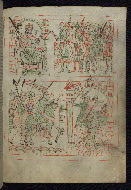
- Title: King Nebuchadnezzar orders soldiers to lay siege to Jerusalem; Jerusalem is taken
- Form: Full-page miniature in two registers
- Text: Jeremiah 39:1-3; Jeremiah 39:8
fol. 3v:
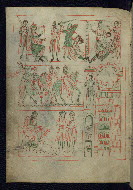
- Title: Execution of King Sedekiah of Judah's sons; Blinding of Sedekiah; Return to Babylon with the blinded king; Jeremiah lamenting before a walled city
- Form: Full-page miniature in three registers
- Text: Jeremiah 39:6-9
fol. 4r:
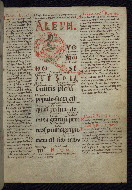
- Title: Initial "Q" with Jeremiah lamenting
- Form: Historiated initial "Q," 4 large lines
- Text: Chapter 1
fol. 13r:
fol. 13v:
fol. 23r:
fol. 23v:
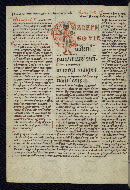
- Title: Initial "E" with Jeremiah mourning
- Form: Historiated initial "E," 3 large lines
- Text: Chapter 3
fol. 37v:
fol. 38r:
fol. 47v:
fol. 48r:
The binding is original.
Plain alum-tawed leather over oak(?) boards; center fore-edge strap meant to fasten to pin on upper board missing; sewn on three alum-tawed straps; endbands of a single rolled alum-tawed core, worked with similar thread to main sewing; double blind lines on each band; saltire cross formed from two double lines on upper board; five small steel studs once on each board, with a six-petaled impression remaining from each of them
Made in Austria in the second half of the twelfth century
Petrus de Anaso, Weyer (ca. 1500 inscription partially erased on front pastedown reading, "Anno etc. 30. Liber dom.[?] Petri de Anaso dominum socio in hospitai Wienn[ensi]")
Johannus Hofulner(?) (sixteenth-century inscription on front pastedown reading, "Hic libellus est Joh[annis] hofulner[?] de Wey[er]")
Benedictine monastery of Seitenstetten by early twentieth century (seen by Hanns Swarzenski there)
Jacques Rosenthal, owned as of 1928, cat. 90, no. 139
Leo S. Olschki, after 1928 (bookplate on front pastedown)
Henry Walters, Baltimore, purchased from Olschki before 1931
Walters Art Museum, 1931, by Henry Walters bequest
Bibliotheca Medii Aevi Manuscripta. Pars Altera: Einhundert Handschriften des Mittelalters vom zehnten bis zum fünfzehnten Jahrhunderts. Munich: Jacques Rosenthal, 1928, pp. 40-42, no. 139, pl. 7 (fol. 3r).
De Ricci, Seymour. Census of Medieval and Renaissance Manuscripts in the United States and Canada. Vol. 1. New York: H. W. Wilson Company, 1935, p. 821, no. 388.
Boston Museum of Fine Arts. Arts of the Middle Ages. Boston: Museum of Fine Arts, 1940, p. 7, no. 18.
Walters Art Gallery. Illuminated Books of the Middle Ages and Renaissance: An Exhibition Held at the Baltimore Museum of Art. Baltimore: Trustees of the Walters Art Gallery, 1949, p. 13, no. 28, pl. 19 (fol. 3r).
Los Angeles County Museum of Art. Medieval and Renaissance Illuminated Manuscripts. Los Angeles: Los Angeles County Museum of Art, 1953, no. 14 (fol. 3r).
Walters Art Gallery. 4,000 Years of Modern Art. Baltimore: Walters Art Gallery, 1953, p. 19, no. 59.
Diringer, David. The Illuminated Book: Its History and Production. London: Faber and Faber, 1958, pp. 181-182, pl. 3-32c (fol. 3r).
Temple Emanu El. Festival of the Bible in the Arts. Houston: Temple Emanu El, 1964, no. 73.
The Israel Museum. Old Masters and the Bible. Jerusalem: Japhet Press, 1965, no. 59 (fol. 3v).
Reeves, Marjorie. Then and There: The Medieval Castle. 2nd ed. London: Longmans, 1988, p. 21.
Von Hülsen-Esch, Andrea. Romanische Skulptur in Oberitalien: als Reflex der kommunalen Entwicklung im 12. Jahrhundert. Berlin: Akademie Verlag, 1994, p. 150, fig. 69 (fol. 3r).
Pirker-Aurenhammer, Veronika. Die Gumbertusbibel: Codex 1 der Universitätsbibliothek Erlangen: Ein Regensburger Bildprogramm des späten 12. Jahrhunderts. Regensburg: Universitätsverlag, 1998, pp. 169-170, figs. 76-77 (fol. 3r-v).
Andrée, Alexander. Gilbertus Universalis Glossa Ordinaria in Lamentationes Ieremie Prophete Prothemata et Liber I: A Critical Edition with an Introduction and a Translation. Stockholm: Almquist and Wiksell International, 2005, p. 89 (as de Ricci 388).
Cataloger: Walters Art Museum curatorial staff and researchers since 1934
Editors: Herbert, Lynley; Noel, William
Copy editor: Bockrath, Diane
Conservators: Owen, Linda; Quandt, Abigail
Contributors: Bockrath, Diane; Clarkson, Christopher; Dutschke, Consuelo; Emery, Doug; Hamburger, Jeffrey; Noel, William; Tabritha, Ariel; Toth, Michael B.
The Walters Art Museum
Licensed for use under Creative Commons Attribution-NonCommercial-ShareAlike 3.0 Unported Access Rights, http://creativecommons.org/licenses/by-nc-sa/3.0/legalcode. It is requested that copies of any published articles based on the information in this data set be sent to the curator of manuscripts, The Walters Art Museum, 600 North Charles Street, Baltimore MD 21201.
